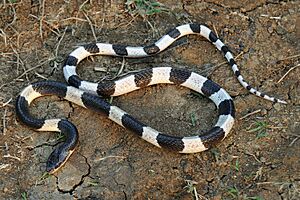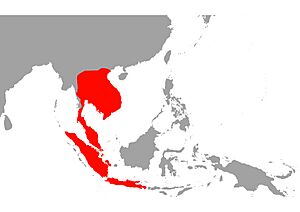Malayan krait facts for kids
Quick facts for kids Malayan krait |
|
|---|---|
 |
|
| From Karawang, West Java, Indonesia | |
| Conservation status | |
| Scientific classification | |
| Genus: |
Bungarus
|
| Species: |
candidus
|
 |
|
| Synonyms | |
|
Coluber candidus Linnaeus, 1758 |
|
The Malayan krait (scientific name: Bungarus candidus), also known as the blue krait, is a very venomous type of snake. It belongs to a group of snakes called kraits. These snakes are part of the Elapidae family, which includes many well-known venomous snakes. The Malayan krait is famous for its distinct colors and patterns.
What Does the Malayan Krait Look Like?
The Malayan krait can grow quite long. It can reach a total length of about 108 centimeters (around 3.5 feet). Its tail alone can be up to 16 centimeters (about 6 inches) long.
This snake has a special pattern on its back. It features 27 to 34 dark bands. These bands can be dark-brown, black, or even bluish-black. They go across its body and tail. The bands become narrower and more rounded on the sides of the snake. The very first dark band connects to the dark color on its head.
The dark bands are separated by wide, yellowish-white spaces. Sometimes, these lighter spaces might have small black spots. The underside of the snake is a uniform white color.
Interestingly, some Malayan kraits look different. In certain areas, like West and Central Java, you might find an all-black version. This type does not have the usual bands.
The scales on its back are smooth. They are arranged in 15 rows along its body. The scales right along its spine are much larger than the others. It has between 195 and 237 belly scales. The scale covering its anal opening is a single, undivided piece. The scales under its tail are also single (not divided) and number from 37 to 56.
Where Does the Malayan Krait Live?
The Malayan krait is found in Southeast Asia. Its home range stretches from Indochina down to Java and Bali in Indonesia. This means you can find it in countries like Cambodia, Laos, Malaysia, Thailand, and Vietnam.
Understanding Malayan Krait Venom
The Malayan krait is known for its very strong venom. This venom is a powerful substance that the snake uses to catch its prey and defend itself. For humans, getting bitten by a Malayan krait can be very serious.
The amount of venom a Malayan krait injects is usually around 5 milligrams. If a person is bitten and does not receive treatment quickly, the chance of survival is about 30-40%. This means it is extremely important to get medical help right away if someone is bitten by this snake.


